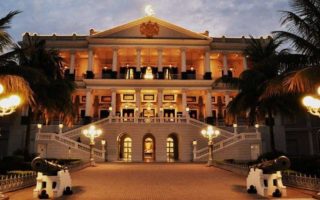The irony of life is that most of the time, we take things at face value. Many things we see, touch, feel, or experience often turn out to be very different from our interpretation. Over time, everything changes. The same is true for the ruins of the Vijayanagara city, which was once inhabited by people like us, in what is now Bellary district of Karnataka.

Location
The ruins of the ancient Vijayanagara city are situated near the Tungabhadra River, at an altitude of 1,864 feet above sea level. This historical site is considered sacred, having once been ruled by the Kishkindha Empire.
There is also a Hanuman temple, Hanuman’s mother’s home, a holy water reservoir, and the homes of a few other mythological figures in the area.
History
Vijayanagara, or the “Town of Victory,” was one of the largest cities of ancient times. With a population of 500,000, it surpassed any other city in the world in terms of population during the sixteenth century.
The Vijayanagara dynasty was founded by two brothers, Bukka and Harihara. Bukka chose Vijayanagara as the capital city of their kingdom. During his reign, the kingdom flourished and expanded significantly.
Like many regions, Vijayanagara faced constant threats from repeated attacks by Muslim emperors. In the mid-sixteenth century, several Muslim rulers from the Deccan Sultanate launched an attack and defeated the kingdom’s ruler.
Once the Muslim armies gained control of the city, they went on a spree of destruction, leaving almost all the structures—including temples and residences—in ruins. The city was never repopulated or rebuilt after this defeat.
- Must Read: Famous Historical Monuments of Karnataka
Structure
A portion of the town, situated between Matanga Hill and Hampi village, has been termed as the “Sacred Centre” by historians.
Another part of the town, separated from the Sacred Centre by a small valley and extending to what is now known as the border of Kamalapuram, is called the “Royal Centre.” This area is so named because it contains the ruins of palaces, temples, and administrative buildings.
The structures that survived despite the damage caused by the Muslim armies include:
Virupaksha Temple
Also referred to as the Pampapati Temple, this temple complex features two courts. It is still visited by devotees who worship Virupaksha, an avatar of Lord Shiva.
Hemakuta Hill
Located to the south of Hampi village, Hemakuta Hill houses numerous temples dating back to the 10th century. Some incomplete structures can also be found here.
Lakshmi Narasimha
Narasimha is an avatar of Lord Vishnu, the cosmic creator. The 6.7-meter-high idol of Narasimha is the highlight, while the idol of Lakshmi, believed to have been disfigured by vandals, was removed and is now housed in a museum in Kamalapuram.
The Narasimha idol rests on Shesha Naag, a mythical serpent believed to be an avatar of the God.
- Also Read: List of Popular Museums in Karnataka
Krishna Temple
A partially ruined temple can be found to the south of Hemakuta Hill. This temple was constructed by King Krishnadevaraya.
Vittala Temple
A 16th-century temple dedicated to an avatar of Lord Vishnu, this structure is located near the village of Anegondi. Outside the temple, one can see the famous stone chariot. The wheels of the chariot were originally movable but were fixed with cement by the authorities to prevent damage.
Kodandarama Temple
This is another functioning temple in the town. The statues of Lord Rama, Lakshman, and Rama’s wife Sita can be seen inside the temple.
Ramachandra Temple
This temple features carvings on the outer walls depicting daily life and scenes from festivals celebrated by the inhabitants.
Lotus Mahal
A palace built exclusively for the royal women, the Lotus Mahal features distinctive architectural patterns influenced by Islamic architecture. Constructed entirely from stone, it stands apart from the traditional structures of the town.
Pushkarani
Pushkarani is a stepped well, once used by the royal women for bathing.
Underground Shiva Temple
This temple has a sanctum sanctorum and an assembly hall with pillared corridors. The base of the temple becomes submerged in water during the monsoon, making it inaccessible during that time.
Elephant Stables
The elephant stables are located next to an open field that was once used by the army for parades.
Designated as a World Heritage Site by UNESCO, the ancient town of Vijayanagara is one of the most significant historical discoveries in the Indian subcontinent.
What to See
Apart from visiting the ruins of the ancient town, visitors can head to the Archaeological Museum in Kamalapuram. This museum showcases objects collected during the excavation of the town, as well as idols of Goddesses and other relics.
How to Reach
The nearest airport to the ruins of Vijayanagara city is in Hubli, located 143 kilometers away. This airport provides direct connectivity to Mumbai and Bangalore.
The nearest railway station from Hampi is located at Hospet, about 13 kilometers away. Direct trains are available to and from several important towns of India, making it easy for tourists to plan their visit to Hampi. Once you reach Hospet station, you can hire an auto-rickshaw to reach Hampi.
Hampi is easily accessible by road as well. It is located 350 kilometers from Bangalore, 150 kilometers from Hubli, 360 kilometers from Hyderabad, and around 800 kilometers from Mumbai.
Visitors also have the option to rent bicycles, which cost Rs 100 per day, allowing them to commute around the town without getting stuck in traffic jams. Alternatively, visitors can hire a private cab, which costs anywhere between Rs 800 to 1200, depending on the make of the car and other factors.


